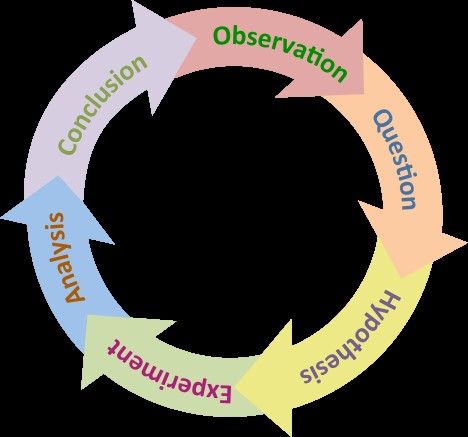Last updated on June 7th, 2017
Call me a nerd, but I sometimes like to fancy myself a mad content scientist. [insert maniacal high-pitched laughter]
Maybe this mindset might mean I watched too much “Bill Nye the Science Guy” as a kid, but having worked professionally as a content creator for several years now I often see correlations between science (my favorite subject in school) and SEO.
Like science, search engine optimization and content marketing requires methodical testing, thoughtful analysis and controlled experimentation.
In case you need a quick refresher on high school biology class, the scientific method is generally divided into six main steps:
- Observe/Question
- Research
- Hypothesize
- Test
- Analyze
- Conclude/Repeat
Okay, so now let’s apply these steps to content marketing and SEO…
Step #1: Ask a question.
What do you want your audience to learn? Whether you’re a full-time copywriter or a head content marketer for your company, determining the purpose of your content – or what question/s you want to answer – should be the first step in the content creation method. This is the point where you ask the who, what, where, when, why, which and how questions. Like scientists, good writers are naturally curious individuals who can see a gap that requires further investigation.
At this point, a topic idea is born. Sometimes these ideas come easily and a topic presents itself; other times you may have to dig for hours and hours until you finally strike gold.
Whichever path you take, eventually you’ll get to the point where you’ve settled on a topic and you’re ready to flesh out the idea.
Step #2: Do background research.
Every good scientist knows how to use the resources they have at their disposal to inform their current experiment and make sure they don’t repeat the same mistakes of the past. Likewise, a knowledgeable content creator conducts thorough Internet research to find reliable information and find the best angle for their piece.
During this step, a writer reads similar content, gathers information, collects sources, interviews experts, takes notes and creates an outline. At this point, an SEO link-building specialist may also conduct competitor research and relationship brainstorming to determine who is going to link to this piece of content.
Step #3: Form a hypothesis.
In the scientific community, a hypothesis is an educated guess or an informed prediction about how to best answer the main question. A good hypothesis is often stated as an “if/then” question (i.e. “If I talk about science too much then people will get a headache and stop reading…”).
In the world of marketing, this step occurs is when the writer or content strategist conducts an SEO keyword study to determine which terms and phrases they should use in their copy. This is also when a skilled content marketer strategizes things like what form their content should take (blog, article, etc.), how long it should be, who their audience is, where it should be published/promoted and other key considerations.
For instance, perhaps data indicates that the audience you’re targeting responds better to visual content. Therefore, presenting your information as an infographic or video rather than a traditional written piece may lead to higher levels of engagement and response. [Hypothesis: If I create this content in the form on an infographic, then it will result in higher traffic, more shares, etc.]
Step #4: Conduct the test.
Once you’ve done your research and the hypothesis is formed, it’s finally time to crack your knuckles and get to the good stuff: writing. This is one of the most important steps in the content creation method.
Be sure to keep the factors from the previous steps in mind such as keywords, audience, word count, etc. By doing so, you’ll be able to determine later if your hypothesis was correct based on the success (or failure) of the piece.
Recording your Standard Operating Procedures (SOPs) the first time you create a new type of content is also a good idea – that way you can easily repeat these steps if it proves to be successful. We also recommend running the same test multiple times to ensure that the first experiment wasn’t just a fluke.
Step #5: Analyze the results.
Once your content is written, edited and published, you can begin the next step: collecting and analyzing the data to measure its success. You should use several different metrics to measure the success of your content – not just website traffic. Average time on page, bounce rate, social media shares and goal completions/conversions are also insightful indicators of your content’s ROI.
Google Analytics is one of the most popular online tools for unlocking data about the performance of your website and its content. Once the code is in place on your site’s HTML, you can view instant, real-time reports about which pages are earning the most traffic, what content convert best, how users are viewing your site (mobile, tablet or desktop) and much more. You can even look at data from individual pages and compare it to other pages.
Step #6: Conclude and repeat.
Finally, examine the data and reach a conclusion. If your hypothesis was proven right, then repeat your steps to get similar results in the future. Or consider changing another variable and repeating the steps above to see how you can improve your content efforts even more.
If not, go back to the drawing board and form a different hypothesis. Try not to be discouraged when your hypothesis is disproven. Rather, take the data you receive and learn from it.
A Message to SEO Content Marketers & Copywriters Everywhere: Embrace Your Inner Mad Scientist
The tricky thing about content marketing is that it’s somewhere in between science and art. Sure, you can greatly improve your chance of success by applying the scientific method to your content strategy, but knowing how to connect with your audience through the powerful medium of the written word is an artform and a skill that takes practice.
So keep practicing. Try new things. Don’t be afraid to fail. And most importantly, own your inner mad scientist.
Here at SEO Advantage, I’m fortunate enough to work with a talented team of both artists (content creators, designers, editors, etc.) AND scientists (strategists, marketers, developers, etc.). If you’re business is looking for SEO copywriting services, we invite you to reach out to us for more information.
From one mad scientist to another, thanks for tuning in and I hope you found this article informative. Feel free to leave us a comment below or on Facebook.




Emmerey Rose says
Thanks Lance for responding! 🙂 Your tips help a lot! Will check the link out. Thanks for sharing!
lanceSEOA says
Great question Emmerey! From my experience, I’ve found that injecting a little bit of humor is one of the most effective (and fun) ways to incorporate some personality in my writing. I think there are plenty of other ways to show the reader your human side though. Much of it relies on having a good understanding of who your audience is. I recommend checking out this post for more info: http://www.seo-e.com/content-marketing-management/buyer-persona-basics.htm. Thanks for the feedback!
Emmerey Rose says
Great article Lance! very helpful tips. I was wondering, how do you incorporate your personality in your writing?
lanceSEOA says
Well said Michael! It reminds me of that quote: “Insanity is doing the same thing, over and over again, but expecting different results.” We have to keep testing new ideas.
Michael LaRocca says
The truly mad are the ones who try to do copywriting without applying the scientific method.
Lisa Banks says
Nice one, Lance! Marketing can learn from the science guys!